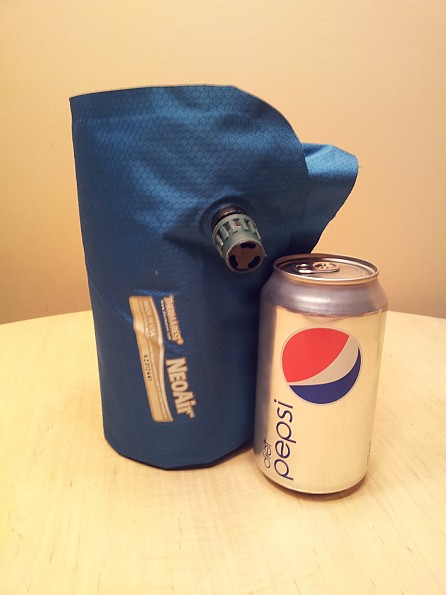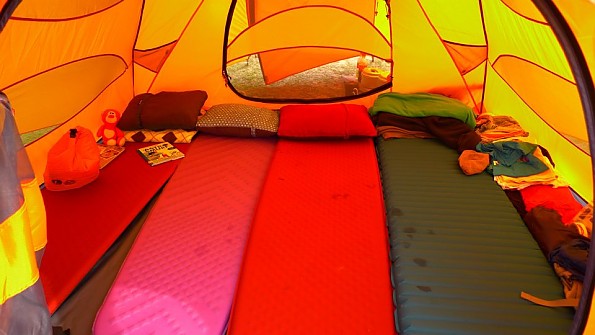Therm-a-Rest NeoAir Trekker

Lightweight, compressible, air mattress for backpacking and backwoods camping.
Pros
- Lightweight
- Comfortable
- Increased R value from previous Trekker
Cons
- Durability
- Price
- Inflation
- Noise
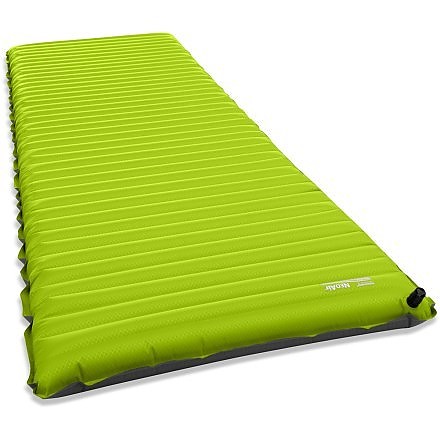
Therm-a-Rest builds a wide array of sleeping pads as most know. Which one to buy is often the hardest question to answer. I have been able to use this in many conditions and after 1,000 miles with the NeoAir Trekker here are some things I have found.
The new NeoAir Trekker comes with an increased R-value of 3.0 from its last model at 2.0. Using a reflective layering inside of the mattress opposed to any sort of foam or fill allowed Therm-a-Rest to increase the R value without increasing any sort of pack size or weight. The triangular cell design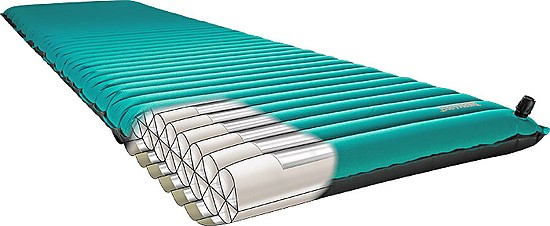
allows the mattress to reflect heat back to your body, while turning the cold from the ground away and back down at the same time. I have personally used this (with a Z-Light SOL) down to ZERO degrees F and found it very comfortable in the cold.
Considering its weight of 1LB 1OZ, and the fact that it is an air mattress, durability is an obvious issue. Weight and pack size however is not. This will pack down as small as a Nalgene 
and weighs less than some cheeseburgers I have recently eaten.
Personally, as I mentioned, I use the SOL underneath the mattress for durability reasons. I am also conscious to make sure this pad is placed on a flat, even, well chosen campsite. As most air mattresses are, these are very prone to puncture. I would never suggest just sticking this thing out in a field under the stars. In a tent it does not seem to have an issue, but in the backwoods it does.
With a 75 denier bottom and a 50 denier top, it is most definitely comfortable and fairly soft, but I would not consider it "strong". In 1,000 miles I have had three punctures, two of which were outside my tent (my fault) and one inside my tent from a missed rock chaffing through the night. Which is not bad at all, but I have been extremely conscious about where I use this. With the SOL I have had no further punctures.
This sleep mattress is extremely comfortable. First off it measures 72x20x2.5 for the regular model which was longer than I was used to. They also have a "torso" model measuring 47x25x2.5 and a "long" model measuring 77x25x2.5.
I have learned to love the length in the colder weather. When normally my feet would be on the ground, the Trekker keeps them up. The rectangular design allows you to move around without compromising comfort. The valve located at the head of the mattress falls perfectly over your shoulder so that once you lay down you an adjust the mattress by letting out air to suit your comfort. The horizontal bafflest allows this to flex well over uneven ground while holding rigidity vertically. 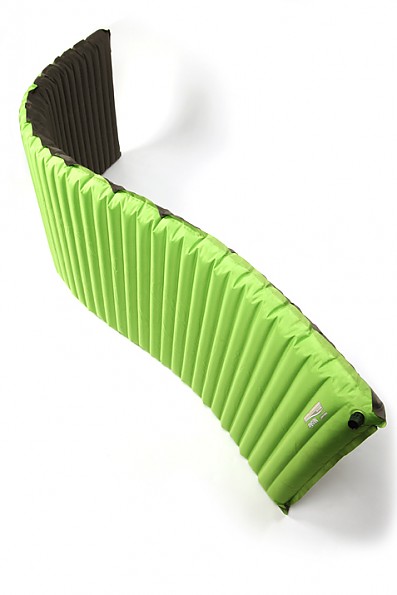
The way they have adhered the top to the bottom is great in the fact that the edges will completely collapse under weight without any ridges or hard spots. I personally love this because my arms tend to do what they want when I sleep and I generally have an issue waking up sore when the mattress is too tall and my arm has been draped over the edge all night. The Trekker allows my arm to lay almost flush to the ground without losing rigidity under my body.
The pad is noisy. This does not bother me personally as I hike alone. However, if you were to show up to a hostel or lean-to rolling around on this all night might upset your company. I have a couple Klymit sleeping pads that alleviate this, but they are heavier. For me, I will trade weight for noise most every time.
The Trekker is also fairly slippery. Choosing a decent flat spot helps tremendously, but it would not be my choice when learning to sleep on the side of a mountain. You do slide around on it, and it does slide around in your tent. Pending which sleeping bag I take, I can actually put this into some of them, folding the top of the pad over a small bit to use as a pillow. This set up actually works really great, but is a bit restricting in some more fitted style sleeping bags. A great idea however when using a quilt style bag.
Blowing up this pad is most definitely an opinion. Personally, I have found it takes about 3 minutes or 30+ normal breaths to blow it up. You can breath normally into it as there is no restriction on the air valve which is nice. 
Personally I put a few breaths into it after setting up camp, go get water and make camp, then go back and finish it. It is tedious to sit and blow it up in one sitting but not obnoxious. The speed valve model seems to help with this. Condensation could definitely be an issue so keeping it inflated for awhile every now and then is a good idea.
There are several other options to blow it up like a compression sack, or electric pump that will alleviate the condensation. Personally I spite the weight as blowing it up doesn't ruin my day. 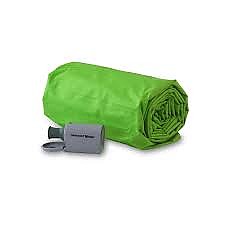
This pad is pricey. They generally sell from $109.95 to $149.95. I was lucky and found a 25% winter sale at my local sporting goods dealer and picked it up for $95.99 for the regular model. I would certainly purchase it up into the $109.95 price point, but anymore and I think I would research a few other options as there are so many.
Overall it's fair to say this is a great pad. That being said there are a lot of options and it would do you well to do some diligence. I generally just fix what's broke, but if I was to replace this mattress I think one thing I would trade weight for would be a bit of durability. There has to be more than 100 options out there for air mattresses, all with their own ups and downs.
Finding out what works best for you will be most important. Although if you wanted a comfortable, fairly warm, lightweight TENTING sleeping pad, this would be a worthy contender.
Source: bought it new
Price Paid: $95.99
A minimalist approach to the inflatable mattress, making sleeping on the ground a lot more comfortable than I remember it. By no means the biggest, warmest, or most comfortable sleeping pad there is, I find this the best compromise that provides me with "just enough." For how small it packs down, heck, that's something I'm willing to live with.
Pros
- Comfortable
- VERY packable small size
- Adjustable firmness
- Lightweight
Cons
- Narrow 20" width [for "regular" size]
- Noisy against tent floors
- Labor-intensive to manually inflate
- Expensive retail price
I couldn't write this review without pointing out the obvious first flaw, and that's the barrier-to-entry retail price of this sleeping pad.
Luckily my birthday falls close enough to Christmas, and I was fortunate enough to receive a pair of these as gifts. First bit of advice: ask Santa for this one, or a loved one the next time a holiday rolls around. Your checking account will thank me.
First impression?
Holy crap, these pack down small.
4" x 9" packed, 19 ounces each.
When I was opening gifts, it wasn't until I opened the box and read the package that I knew what I was getting. Deflated, folded into thirds, and rolled up, they take up less space than a Nalgene bottle. More than a soda can, but less than a Nalgene bottle.
Here's the pad in the included stuff sack (note I've also packed my battery-operated Camp-Tek Microburst Pump in with it):
Setup is simple, but labor-intensive. It takes — easily — a couple dozen FULL lung-fulls of air to get these pads inflated. After an exhausting day on the trail, this is right up there with tick removal when it comes to the "fun chores" category.
Untwist the valve counterclockwise to open it.
Blow like you're trying to put out the Great Chicago Fire.
And tighten it back up clockwise when you've reached your desired firmness.
I usually keep my mouth over the valve until I'm COMPLETELY done inflating it, so I don't lose any firmness at all.
Luckily, battery-operate pumps are available. I bought a Microburst from Camp-Tek and it does the work for me in about five minutes or so. Nice, too, in that I can let the pads inflate while I set up the rest of camp. Let's hear it for multitasking, folks.
I have a set of the regular-size pads, which measure 20" W x 72" L x 2.5" T when fully inflated.
Luckily I'm an even six feet tall, and am a skinny guy, so this size works just fine for me.
For reference, here's the pad with a Marmot Trestles 15-Degree Sleeping Bag (Women's Regular, which fits a maximum height of 6' - 0") on top of it:
No, there's not a lot of room to roll around, and no, it's not the longest pad, but it fits into my tent and provides me just enough sleeping space without taking up unnecessary room in my tent.
Some folks prefer vertical baffles, opposed to the horizontal ones seen here. I'm not much of one to roll around in my sleep, and I've certainly never rolled off my sleeping pad entirely in the night, so this feature comes down to personal preference.
Before using these, I would sacrifice 4/5ths of my tent floor space (in a 4-person tent) by sleeping on cots. I got so irritated with losing all the valuable square footage that I resolved to find a more space-efficient way of sleeping, and sleeping comfortably.
These pads are the best possible compromise, taking up no more room than they have to, and still allowing me a comfortable night's rest without eating up the square footage (or headroom) in my tent.
Sure, I could have bought the longer version of the pad, but that would not only negate the packability and weight of the regular size, but run the risk of touching my tent walls and being a magnet for condensation.
Where insulating value and warmth are concerned, a 2.0 R value makes this no more than a 3-season pad. Being a spring-through-fall camper, this is more than enough for me.
Biggest complaint I wish they did something about, like others mentioned, is the noise.
These things swish against a tent floor more than an overzealous jogger in a windbreaker. I know you can bring an extra sheet to keep them from sliding around, or use your flannel bag liner. Already using the bag liner, well, in my bag, this doesn't exactly work for me. Something about the material on the bottom being non-textured seems to encourage it (100D poly, top is a 75D textured poly).
This isn't the perfect solution for my sleeping needs, but like I said, it is the best compromise.
Source: received it as a personal gift
A lightweight sleeping pad weighing in at 19 oz and packs up quite small. Somewhat loud and quite narrow. Very expensive when bought at full price. However, the size and weight are definitely pluses for this sleeping pad.
Pros
- Lightweight
- Deflated size and small pack size
- Thick at 2.5 inches
Cons
- Expensive
- Narrow
- Somewhat loud
- Included stuff sack is too big for the actual pad
- Did I mention expensive?
I bought the Regular sized Neo Air Trekker on discount from Campsaver.com for around 65 bucks a few months back when they had an added 10% discount on all outlet items. The pad I bought was an "Irregular" version which meant a further discount. At full price, the pad is over 100 bucks... which seems like A LOT of money for this sleeping pad.
I do not currently use the optional pump for this mattress and I fill the sleeping pad with good ol' lung power. I haven't really had an issue with blowing up the mattress myself and cannot justify spending more money and increasing pack weight by purchasing the optional pump.
I've used the Neo Air Trekker in various conditions now, including a most recent trip (7/12-7/13) to Weaver Lake in the Jennie Lakes Wilderness where temps dropped to approximately 45-50 degrees. Any chill from the ground was not a factor at all. I believe the new Neo Air Trekker All Seasons have an increased R-value which provides even more warmth at the same weight. However, the new model is also a whopping $150 retail which I am not prepared to spend.
My first impressions of the mattress was that it was similar to an inflatable pool mattress with tougher materials. I have not used the lighter, yellow Neo Air version, but supposedly, the Neo Air Trekker is constructed of tougher materials. As mentioned in previous reviews, the Neo Air Trekker is quite loud. However, once setup, it is relatively comfortable (esp. compared to CCF pads) given the 2.5" thickness.
The mattress is a little on the narrow side, but I am of slight build, so it's not too much of a factor for me. However, ultimate comfort is difficult to achieve on this mattress for side sleepers, due to the narrow construction of the mattress. It seems as this mattress would be most suitable for sleepers who primarily lie on their backs. The baffling construction also provides nice back/lumbar support when filled firmly after a long hike.
As aforementioned, the biggest plus sides to this mattress is the weight and the pack size. While I found the included stuff sack to be too big for the actual mattress, I used the stuff sack from my Patagonia Down Sweater as a stuff sack and it fits perfectly. Furthermore, this mattress weighs only 19 oz, which is a definite upgrade from my previous self-inflating ALPS Mountaineering "Lightweight" Series Pad which clocked in at over 2 pounds and was very bulky. However, comfort wise, I would say I preferred the ALPS pad over the Neo Air Trekker, even though the ALPS pad is only listed as 1.5" of thickness from the ground compared to the Neo Air Trekker's 2.5". The padding within the ALPS pad, as well as the width, seemed more conducive to side-sleepers.
The biggest drawback to this product is the price. True, I do appreciate that this mattress is made within the United States and I'm all for the increase of manufactured goods within the U.S. However, at $100+ dollars retail, for essentially some denier polyester and synthetic insulation seems a little much. Of course, if you had the expendable income, price would not be an issue as the weight and pack size would trump the cost. However, I would have a difficult time paying the retail price for this product without any discounts.
In regards to air leaks, I have not had any of the leakage problems as detailed within other reviews (knock on wood!) as the Neo Air Trekker has held up within a handful of uses. But with the price incurred for these mattresses, I would be quite discouraged if I had experienced air leaks after only a few uses.
Here's a pic at of the NeoAir Trekker inside my tent at Weaver Lake: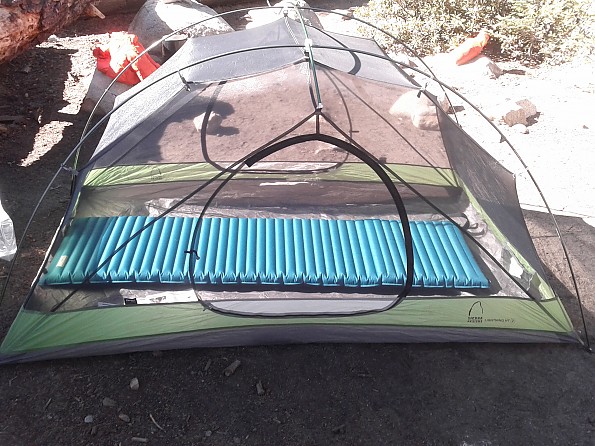
The NeoAir Trekker in the Patagonia Stuff Sack next to a 2L Platypus:
Source: bought it new
Price Paid: 65 bucks
This mattress will give you such a good night's sleep you'll never complain about having to blow it up at the end of a day!
Pros
- Incredible weight-to-R-value ratio (17 oz. to 3.0)
- Durable and well constructed
- Quiet(er)
- Packs down small
- Excellent value overall for a three-season pad
Cons
- Well, you still have to blow it up and deal with deflating and rolling, but, hey...you'll be well rested!
- Narrowish but I adjust
Just getting one thing straight up front: I need my sleep or I am a HUGELY grumpy bear of a hiker that no one wants to be near on the trail! The most important thing to me on any trip out is the quality of my sleep system.
I have tried those raggedy old flat pads with no air or cushion to save their names and they are just not for me. Yes, an air pad and my beloved SD Backcountry Bed will probably forever keep me from the ranks of the ultralight.
Meh. :-)
Now, to the review.
I tried the Therm-a-Rest XLite pad before settling on this one. The XLite was like sleeping on a potato chip bag...it was that noisy! So I sucked it up and put 5 ounces more into my base weight and have never regretted it! This is a really amazing pad! I have used it for two years and all three seasons, from camping at the ocean to 6000+ ft.
CONSTRUCTION AND DESIGN
The construction is excellent. It is a quality product and I found it to be a real value for the price. The bite valve for blowing it up is solidly on there, so will not separate from the pad at a later date. Seams are tight and the materials are sturdy! I would have to sleep on bare ground and sharp rocks before I started to worry about poking a hole in it.
I am a big fan of the horizontal baffle for keeping you ON the pad at night. Additionally, the top surface has a really nice, soft covering although you can still slide around a bit.
It will inflate to 2.5 inches if you need it to, but I deflate it a little in order to not roll off of it. As a side sleeper this has provided excellent cushioning between my hips and the ground.
SIZING
I have a regular sized pad but there is a long version. The regular is plenty long for me at 5'7" but I find the 20 inch width to be narrow. As a woman with wider hips I would have liked a little more but there is a reason I don't complain:
**Big caveat here:** if you need the long version remember that you are getting a wider pad, in this case a 5 inch bump up (2.5 inches on either side.) If you have a sleep system that utilizes a sleeve for your sleeping pad you will need to make sure that your sleeve can accommodate the increased measurement. My regular sized SD Backcountry Bed will not (hence I adjust rather than whine).
WEIGHT AND WARMTH: I found the R rating of 3.0 to be very efficient and have never felt a cold night even down to 30 degrees. This is saying something as the SD Backcountry bed has NO down underneath you...just on the top and sides of you. So all the warmth under me is supplied by the pad alone!
For this I give it my highest rating! Add to this the fact that you get this feature for only 17 ounces of weight and you really can't beat it. Additionally, because the weight is down the pad folds up nice and small and is easily fit into your backpack!
POSTSCRIPT: There is a four-season version of this pad that adds almost two R-values, but no extra weight. I can't speak to this as I haven't checked it out, but thought I would add that to the review for people who are cray cray enough to sleep on snow. :-D
Source: bought it new
Price Paid: $129
Surprisingly light, compact and durable!
Pros
- lightweight
- small size when packed
- durable than the NeoAir
- very comfortable
Cons
- annoyingly noisy
- needs to blow air
Here is my sleep system:
EASE OF USE:
Blowing air into the pad is not that fun! However when you passed this predicament you would immediately noticed how comfortable it is. With 2.5in cushion and a rugged 100D polyester bottom, you are in dreamland in no time!
I would have easily rate it 5 stars if not for the noise it makes everytime you move. My wife complained that the noise it makes is so annoying that it wakes her up.
I have no issues with its lower R value compared to the NeoAir, since I mostly camp in Hong Kong. Winter here has its low at around 3-10°C. Surely far from the limitations of the Trekker.
Source: bought it new
Price Paid: USD 105
I'm 90 Kg and 185 cm and live in Australia.
I've spent about 20 nights on my NeoAir in Australia. Most of that time was in the Aus winter and outside nighttime temps of about 5'C in a WM -7'C bag and a Marmot Hydrogen -1'C bag, OR Alpine Bivy and under a tarp. I wear merino thermals in to bed and sometimes socks. I've been through severe winds, frost and extreme rain.
In those conditions I found the -1'C bag fine however I was cool underneath and I woke up several times from the disturbance. Knowing I had an extended expedition coming up, I purchased the WM -7'C bag and had very comfortable nights sleep for 10 days of 5'C (or lower) nights.
NeoAir is very comfortable and extra lightweight, low bulk for those that want that (me!!). I liked it so much I am purchasing another one as the large is just too long for my bivy bag. Large is ideal for a tent.
Price Paid: $AU150
Pros
- Low cost compared to similar pads on the market
- Packs small and light
- Well made
Cons
- 20" wide is tiny for a adult male
- 2.5 inches thick is okay but not great
- Insulation is minimal
I use this for motorcycle camping so I might have opted for a thicker pad. However it was $60 from Academy Sports.
Source: bought it new
Price Paid: $60
Trying to save weight, I bought a Neo-Air about a year ago (it's the light version of this one). I've had two of them now and they both leaked. Since Thermarest won't repair them, REI (the best company ever) gave me a Trekker. After a few days of trying it out, I decided not to use it and thought I'd share my reasoning.
The second Neo-Air I had left me freezing one night last month in Shenandoah National Park. I've been backpacking for a long time and made a rookie mistake by not having supplemental ground protection as you should for any inflatable mattress. Think what you want but they're just for comfort. My belief is that if you have to carry additionally insulation anyway, why not save weight and stick with the Neo-Air instead of the additional weight of the Trekker.
The inflatable advocates will argue that they are reliable and all that. I agree to a point but here's the bottom line: All it takes is one leak on one winter night...that's it. Carry the lightest inflatable and supplement it with a thin closed cell. Thanks, Frank
Price Paid: $139
Lasted me about a week before it blew a hole somewhere I can't find... Not even submerged in the bath tub. No repair kit included. Tired of air mattresses leaking. I switched to Clark Jungle Hammock and haven't looked back. Product best for a recall. Would not recommend.
Pros
- None
Cons
- Will cost you $100 or more for nothing
As I said in my summary, complete waste of money. Lasted about 6 nights. Can't find the leak and even if I did they did not include a repair kit. No gear stores out in the bush in Costa Rica either, so on the ground I was.
I did my research and read reviews stating the same, but thought they were just sour grapes... Yhey were right. Hope this helps save you some money.
Source: bought it new
Price Paid: $130
Terrible.
Pros
- Light
- Small
Cons
- Slippery
- Noisy
- Expensive
Not much to say. Slippery, slides all over your tent, it's noisy, it's easy to inflate, however when you're tired it sucks to inflate it. The air nozzle is situated on top where you sleep. Not only is it a terrible design you bump into it when you sleep as it stands up. It is very light and packs very well.
I personally did not find it comfortable. I am now sleeping on a MEC Reactor 2.6. Nice pad and packs better than Therm-a-Rest (comparable).
Source: bought it new
Price Paid: $120
Your Review
Where to Buy
You May Like
Specs
| regular | large | ||
|---|---|---|---|
| Price |
MSRP: $119.95 Historic Range: $61.11-$179.95 Reviewers Paid: $60.00-$139.00 |
||
| Dimensions | 20 x 72 in / 51 x 183 cm | 25 x 77 in / 63 x 196 cm | |
| Packed | 9 x 4 in / 23 x 10 cm | 11 x 4.5 in / 28 x 11 cm | |
| Weight | 1 lb 4 oz / 570 g | 1 lb 8 oz / 680 g | |
| R Value |
2 |
||
| Thickness |
2.5 in / 6.3 cm |
||






